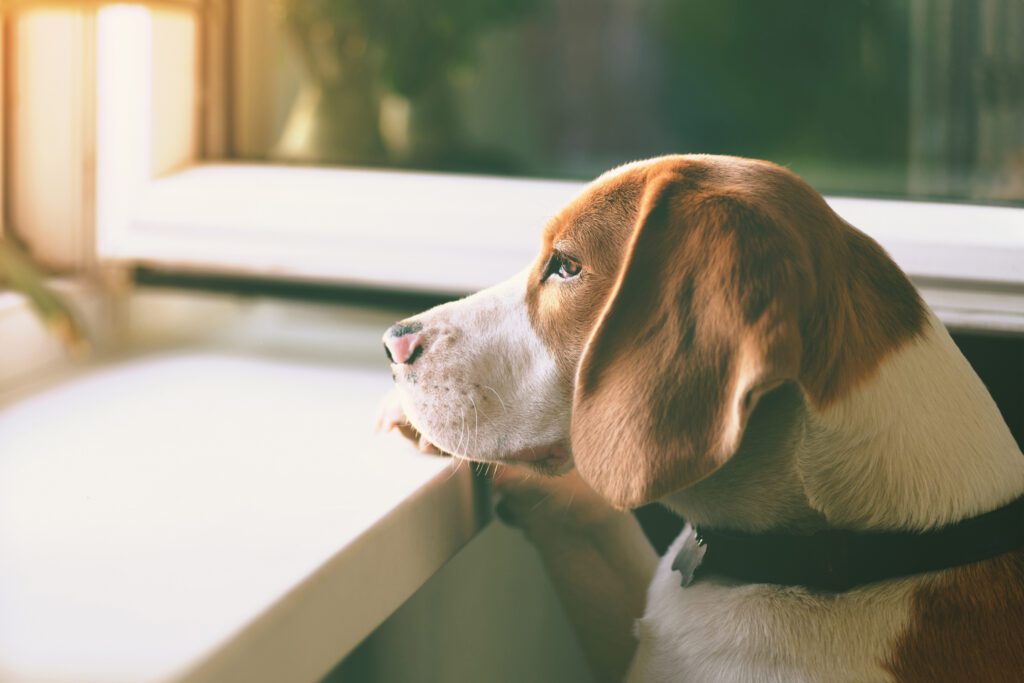Anxiety Affects Both Humans and Animals
Unfortunately, for our pets it often goes undiagnosed. This is because the symptoms can be difficult to detect in animals and are often mistaken for disobedience, aggression, or something else. In this article, local veterinarians Dr. Tony Ashley of Animal Clinic Inc. of Chattanooga, and Dr. Katie Smithson of Chattanooga Holistic Animal Institute help shed light on the often-missed signs of anxiety in your pet and provide valuable advice for how you can help.
Symptoms
Recognizing symptoms of anxiety is the key to properly diagnosing your dog or cat and preventing misinterpretation of their behaviors.
Recurring symptoms like vocalizing (barking and meowing), destroying walls, doors, and furniture, using the bathroom inside, or even just ignoring a command can all be signs of anxiety – and these are obviously, easily mistaken for a misbehaving pet.
Other symptoms may include freezing in place, refusal to eat (while anxious, won’t take treats), hiding, or even aggressive behavior.

When an animal hisses, growls, or lashes out in a defensive manner, it’s often because they feel confined and threatened. It’s also important to note that cats and dogs will differ in their responses. Dr. Smithson says, “Fearful cats are usually not subtle about their anxiety. They may puff up or hiss and may tend to be more confrontational. Conversely, dogs may be more subtle, especially at first.”
Many of these behaviors, in isolated instances, are normal reactions to fear-inducing stimuli. However, if you observe your furry-friend exhibiting some of these behaviors on a regular basis, you may have an overly anxious pet. “Each animal is unique and their responses will differ based on their personality as well as the triggering event,” explains Dr. Ashley.
Causes & Types of Anxiety
If you begin to notice a pattern of anxious behaviors in your pet, the next important element to watch for is what may be causing their anxiety. Often, the anxious behavior will result from the same “trigger” or “triggers” every time. Triggers are stimuli that illicit a fearful response, and according to Dr. Ashley, there are three common types of triggers: separation, new people or locations, and noise.
If your pet exhibits anxious behaviors when you’re gone from home or about to leave, they’re likely suffering separation anxiety, which is one of the most common types of pet anxiety. If they tend to be fearful anytime they’re in a new location or around new people or animals, they may have anxiety related to unfamiliar situations. And lastly, if fireworks, thunder, the vacuum, or other loud noises have your dog or cat running for cover, they are possibly suffering from noise anxiety.
Dr. Smithson explains, “The natural ability to cope with stressful situations and overcome fearful influences are related to breed, brain chemistry, and early learning during the socialization period.” But she also reminds us that there are no specific breeds predisposed to anxiety. And Dr. Ashley corroborates, “Anxiety often occurs due to poor socialization during a specific time frame as a puppy or kitten. For this reason, anxiety is more common in shelter or rescued animals.”
Effects
Effects of anxiety on your pet are ususally circumstantial, but the good news is, they are rarely physical. If the anxiety progresses, especially with no intervention, Dr. Smithson points out that it could lead to phobia – which is an extreme emotional and physical state of distress in response to a real or anticipated threat. Phobias, and even prolonged anxiety, can lead to interrupted eating, sleeping, and bathroom schedules which could be detrimental to your pet’s health.
Additional effects, as Dr. Ashley points out, have to do with anxious animals
missing out on quality-of-life standards. For instance, he explains that anxious pets are sometimes released to shelters due to their destructive or aggressive behavior. They also can receive poor medical treatment because they are so challenging to examine. “No one likes to be scared, and we don’t want our pets to feel this way either.”
In worst case scenarios, animals with severe anxiety and panic disorders can become consumed with the thought of escape. When a pet reaches this level of panic, they often disregard normal self-preservation instincts and can injure themselves, their owner, or others in an attempt to flee the fear-causing stimuli.
Separation Anxiety

Managing One of the Most Common Types of Pet Anxiety:
One of the most common types of anxiety is separation anxiety, and it most often occurs in dogs. If you’re struggling to leave your pup at home alone, Dr. Smithson lays out a few tips to help them acclimate to daily life at home alone.
Desensitize to Separation
Dogs will quickly learn ques that indicate you’re leaving (keys jingling, putting on your shoes, etc.) Help these signals bear less weight by performing them at random. Put your shoes on and walk out the door, then come right back in. Jingle your keys as if to leave, then sit back down. After time, their effect on your dog’s psyche will dissipate.
Help Them Relax While You’re Gone
If left alone, confined, and unstimulated all day long, your pet is much more likely to become worked up into an anxious state. Leave the television or radio on to create a less lonely atmosphere, leave behind a reward that is only present when you aren’t (a toy or treat), or you can even look into a diffuser or scented collar that contains a “D.A.P.” or dog appeasement pheromone. The scent is naturally relaxing to canines.
Discourage Hyper Attachment
If your dog, suffering from separation anxiety, seeks your attention as soon as you arrive home, resist the urge to give them attention. If more than one person lives at home, divide the responsibility of caring for the pet so they are not solely dependent on one person. And encourage them to play with toys independently.
Managing Anxiety
Anxiety is a mental disorder that is rarely spoken about in finite terms of “curable” or “incurable.” However, both Dr. Smithson and Dr. Ashley offer reassuring news that total maintenance and a normal, happy standard of living is within reach.
Preventing and managing all forms of anxiety in animals can involve: socialization, acclimation or behavior modification (which go hand in hand), and/or medication.
As Dr. Ashley points out, “Prevention is always better than medication.” Possibly the most important preventative is early socialization. This is key to preventing the most common types of animal anxiety. “The socialization period is the time frame when puppies and kittens easily adapt to different situations. It usually ends before eight weeks of age, but this is an important time for young animals to be exposed to people, other animals, locations, and situations that will help them be less fearful at a later point in life.”
After socialization, acclimation and behavior modifications can help. If you can work with your dog or cat to acclimate them to their triggers, the anxious response should be lessened over time. For example, if they fear new people, help them ease into meeting new people more often with positive experiences such as receiving treats. This helps acclimate them to the trigger while modifying their anxious behavior with rewards.
Consulting with your vet or an animal behavioral therapist will help you form a more sophisticated plan for management. And if your furry loved-one is still struggling to find a sense of calm, there are medications, and even natural supplements that you and your vet can select, based on your pet’s needs.
For those interested in a jobs or a career in the veterinary field, you can check them out here.

Dr. Katie Smithson
Veterinarian, Chattanooga Holistic Animal Institute

Dr. Tony Ashley
Co-owner & Veterinarian, Animal Clinic Inc. of Chattanooga
